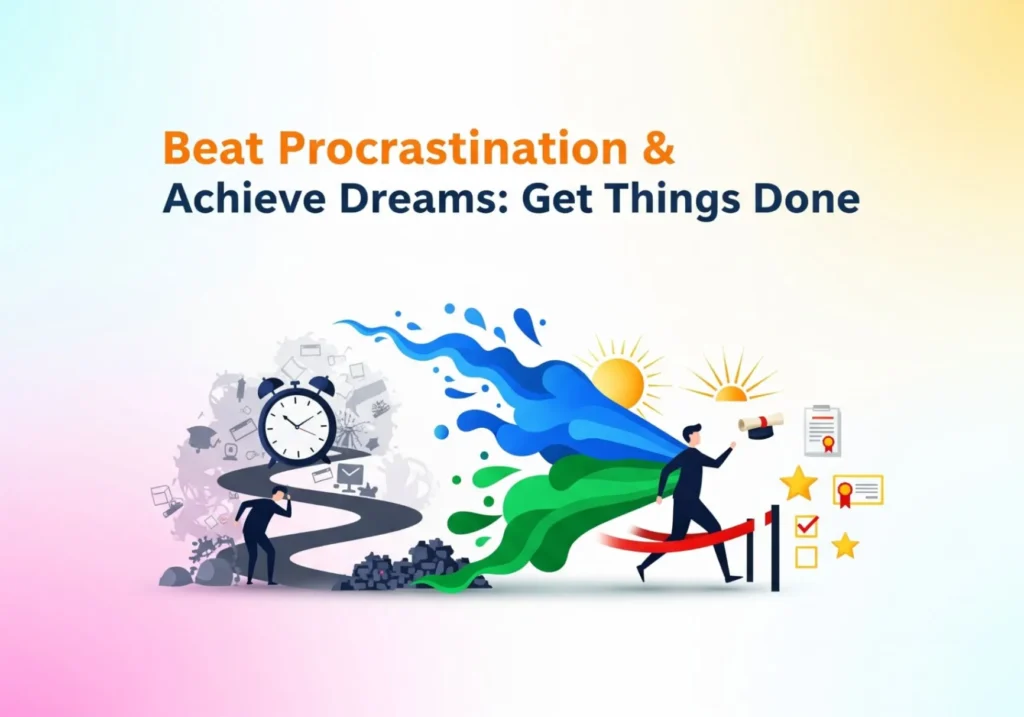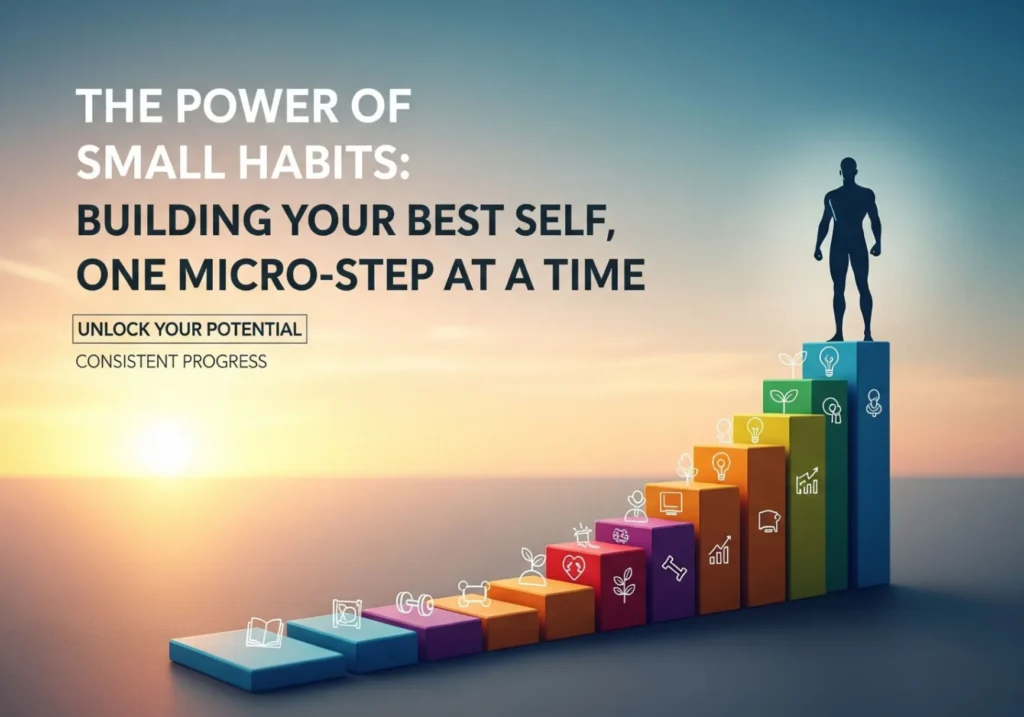Beat Procrastination & Achieve Dreams: Get Things Done

Introduction: The Dream Thief Called Procrastination
We’ve all met it. That sly, seductive whisper that says, “Later. Tomorrow. Not right now.” It’s the voice of procrastination, a universally experienced phenomenon that stands as one of the most formidable barriers between our current reality and the vibrant dreams we hold for our future.
It doesn’t discriminate based on intelligence, talent, or ambition. The good news? This struggle is not insurmountable.
Beyond Laziness: Understanding Procrastination’s True Nature
It’s tempting to label procrastination as simple laziness, but this is a harmful misdiagnosis. Procrastination is rarely about an unwillingness to work; it’s a complex emotional regulation problem. It’s our brain’s way of trying to avoid negative feelings associated with a task – feelings like boredom, frustration, anxiety, or fear of failure. We opt for a temporary mood boost, even if it means greater stress later.
This comprehensive guide is your roadmap from chronic procrastination to consistent, inspired action. We will delve deep into the psychology behind why we procrastinate and equip you with a powerful toolkit of practical, actionable, and inspirational strategies to get things done.
Unmasking the Enemy: Why Do We Really Procrastinate?
To combat procrastination, we must understand its hidden roots. It’s a multifaceted beast fed by a variety of psychological triggers.

- Fear: The Paralyzing Trio. We fear failure, we fear success (and the high expectations it brings), and we fear judgment from others. Procrastination becomes a self-protective mechanism to avoid potential pain.
- Perfectionism: The Unattainable Standard. Perfectionism and procrastination are two sides of the same coin. The fear of not doing something perfectly can be so overwhelming that it’s easier to not start at all.
- Overwhelm and Lack of Clarity. When a task feels too big, complex, or vague, our brains default to avoidance. We spend more time worrying about the task than taking the first small step.
- Task Aversion: The “I Just Don’t Want To” Factor. Some tasks are just boring or difficult. Our brains seek pleasure and avoid pain, so we put off the unpleasant feeling in favor of something more gratifying right now.
- Low Energy and Decision Fatigue. When we’re physically or mentally drained, our capacity for tackling challenges plummets, making procrastination incredibly tempting.
- The Brain’s Innate Bias: Seeking Instant Gratification. Our brains are hardwired for immediate rewards. Scrolling social media provides an instant dopamine hit, while the reward for a difficult task is often delayed. Procrastination is a victory for our “present self” over our “future self.”
The Hidden Costs: What Procrastination Silently Steals
Procrastination might offer fleeting relief, but its long-term costs are far-reaching.
- The Emotional Toll: The temporary relief is quickly replaced by a vicious cycle of stress, anxiety as deadlines loom, and guilt for not meeting our own expectations.
- Missed Opportunities and Stifled Potential: Procrastination is a dream killer. The brilliant idea never developed, the skill never learned, the application never submitted—these are the silent casualties of delay.
- Damaged Self-Esteem: Consistently failing to follow through on our intentions erodes our self-esteem. When we repeatedly break promises to ourselves, we start to doubt our own capabilities.
- The Ultimate Price: Unfulfilled Dreams. The most significant cost is the quiet tragedy of a life tinged with a sense of incompleteness, where our deepest aspirations remain perpetually on the “someday” list.
The Procrastination-Busting Toolkit
Practical Strategies to Get You Moving
- Practice Self-Compassion & a Growth Mindset: Stop beating yourself up. Acknowledge that procrastination is a common human struggle. Believe that your abilities can be developed, and see setbacks as learning opportunities.
- Break It Down (Chunking): Take an overwhelming project and dissect it into the smallest possible actionable steps. Smaller tasks feel less intimidating and build momentum.
- Use the “Two-Minute” or “Five-Minute” Rule: The hardest part is starting. Commit to working on a dreaded task for just two or five minutes. Often, once you overcome that initial resistance, you’ll find it easy to continue.
- Transform Time Management (Pomodoro, Time Blocking, Eat That Frog): Work in focused 25-minute sprints (Pomodoro), schedule specific tasks into your calendar (Time Blocking), or tackle your hardest task first (Eat That Frog).
- Set SMART Goals with a Powerful “Why”: Vague goals invite procrastination. Make your goals Specific, Measurable, Achievable, Relevant, and Time-bound. Connect each goal to your core values.
- Design Your Environment for Focus: Minimize distractions by turning off notifications and clearing your workspace. Prime for action by having everything you need ready to go.
- Use Accountability: Find an accountability partner or join a group. Knowing someone else is aware of your commitment is a powerful motivator.
- Reward and Reinforce Progress: Celebrate small wins and milestones, not just the final outcome. This reinforces the act of working and makes the journey more enjoyable.
- Tame the Inner Perfectionist: Give yourself permission to produce a first draft that is not perfect. “Done is better than perfect” when perfect never arrives.
- Use “If-Then” Planning: Pre-decide your actions. “When it’s 9 AM, then I will work on my report.” “If I feel the urge to check my phone, then I will take three deep breaths.” This reduces reliance on willpower.
Kickstarting Your Dreams: Connecting Action to Aspirations
Overcoming procrastination isn’t just about ticking off more tasks; it’s about clearing the path to achieving your most meaningful dreams. When your daily actions are consciously connected to a larger, inspiring vision, motivation becomes more sustainable.

- Reconnect with Your “Why”: Your “Why” is the deep, personal reason behind your goals. Regularly revisit it to reignite your commitment. It transforms a “have to do” task into a “get to do” step.
- Visualize Success: Vividly imagine yourself achieving your dream. This creates a compelling “future pull” and makes the abstract goal feel more tangible and attainable.
- Take That First, Brave, Imperfect Step: Your first step doesn’t need to be perfect; it just needs to be taken. Shift your immediate goal from “finishing” to simply “starting.”
- Build Momentum: Small wins breed confidence. Action generates clarity. Motivation follows action (not the other way around).
Maintaining Momentum: Strategies for Long-Term Success
Overcoming procrastination isn’t a one-time fix; it’s an ongoing practice of awareness and adjustment.
- Schedule Regular Reviews: Dedicate time weekly and monthly to review your progress, challenges, and strategies with self-compassion.
- Apply the “Never Miss Twice” Rule: If you have a slip-up, make it an absolute priority to get back on track the very next day. One missed day is an anomaly; two is a new pattern.
- Continuously Learn and Adapt: Experiment with different techniques to find what works uniquely for you.
- Celebrate Milestones: Acknowledge how far you’ve come. This reinforces your new identity as someone who takes action and gets things done.
Conclusion: From Procrastinator to Creator – The Power is Yours
We’ve journeyed deep into the heart of procrastination – unmasking its guises, understanding its costs, and arming ourselves with a comprehensive arsenal of strategies to overcome it. The path from chronic delay to consistent action is not about achieving flawless discipline. It’s about understanding ourselves better, cultivating self-compassion, and consistently applying proven techniques.
The power to change your relationship with procrastination and to kickstart the dreams that set your soul alight resides firmly within you. It begins not with a monumental leap, but with a single, intentional choice to act differently, right now.
Knowledge is powerful, but action is transformative. As you finish reading this guide, let it be a catalyst. What ONE tiny, manageable step can you commit to taking today to move your dream forward?





Your Turn!
What’s one strategy from this toolkit that resonated most with you? And what is one tiny, brave step you will take today to beat procrastination? Share your commitment in the comments below!